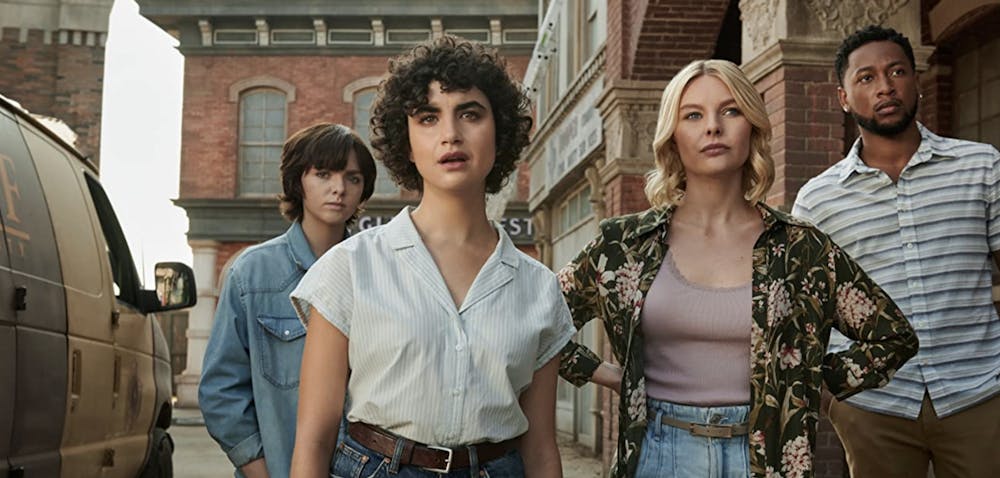The Texas Chainsaw Massacre franchise has a long and storied history of sequels, remakes, and reboots. The sheer number of new timelines is convoluted even in this age of constantly reviving long-dead franchises for nostalgia’s moneymaking powers.
In the latest sequel, a group of young influencers have bought a ghost town in rural Texas and plan to sell off the buildings to city-dwelling business owners. The problem with this idea is that the elderly orphanage owner and her last remaining ward—a suspiciously tall, silent figure with murder in his eyes—didn’t get the memo about moving out of their house. The influencers insist they leave and before you know it, there’s an infuriated Leatherface running around town, cutting down yuppie restaurateurs with his trusty chainsaw.
Just as a bunch of city slickers fail to revitalize the rundown town of Harlow, Texas, this movie fails hard at doing anything new or exciting with the Texas Chainsaw franchise.
Worse than it Looks
To extend this movie some mercy, there’s nothing technically wrong with it on the production side. The film is competently made in terms of visuals and we even get some oddly lovely shots of the southern countryside, but it lacks a unique style or flair. The color palette could be described as rust.
The aging Leatherface takes on an eerie, somewhat decayed appearance in his full fleshy getup. That and the overalls have him feeling reminiscent of the ever-iconic Harold from Scary Stories to Tell in the Dark.
More than the original film, this installation evokes the Platinum Dunes duology of remakes from the early 2000s, particularly in its gore. Lots of exposed bones and gushing blood, not to mention the number of chainsaw kills that seems to get higher with each new entry to the series—this one being no exception. Perhaps it’s a symptom of horror movie desensitization, but it doesn’t feel like much to me. The whole film, in fact, doesn’t feel like much.
Where’s the Beef?
The biggest and most inexorable flaw of Texas Chainsaw Massacre is that it is painfully lacking in substance.
This is the first movie to bring back the original final girl, Sally Hardesty, in any official capacity but it doesn’t use that opportunity for anything meaningful or interesting. If you were hoping to see character depth on the level of Jamie Lee Curtis as the gun-toting, laser-focused bundle of trauma, Laurie Strode, in the last few Halloween movies, you’ll be sorely disappointed. There’s hardly anything that stands out about Sally and it’s easy to forget that she’s part of the story when she’s not on-screen.
The other actors are doing their best with their new characters, but there’s so little for them to work with. Elsie Fisher, who readers may know as the fantastic young lead from Eighth Grade, feels wasted on this movie. Not even she can add depth to her paper-thin character, Lila, who seems less like an individual and more like a replacement for Franklin Hardesty from the first movie. Rather than being wheelchair-bound, Lila’s wounds are psychological, and this has “severely strained” her relationship with her sister, Melody. "Severely strained" is in quotes here because their interactions are nothing but commonplace until suddenly they’re snapping at each other and Melody claims that Lila is too traumatized to be independent. Of course, this leaves her open for a character arc focused on taking matters (and chainsaws) into her own hands when face-to-face with a killer, but it doesn’t feel satisfying given the lack of evidence of a supposed weakness she has to overcome. It’s exactly the kind of limp storytelling that gets writing back from the editor with “Show Don’t Tell” written in big red letters in the margins.
But few people watch these bloodbath films for a deeply compelling protagonist, so what’s the problem? This question begs another question: If you change the names, what even makes this a Texas Chainsaw movie?
Leatherface, one of the most iconic characters in both horror and American pop culture, is almost completely stripped of identity. He sure is wearing a mask of human flesh over his face, and he sure is killing people with a chainsaw, but something vital is missing. Change his name, remove these accessories, and he has no real personality to speak of. He’s just another mute mountain of meat like so many other horror baddies that don’t get remembered for decades. He doesn’t even eat people! And it’s not just that he’s a far inferior incarnation of the character, it’s that this isn’t what makes a compelling villain.
I struggle to find more unique things to say about Texas Chainsaw Massacre because its problems themselves are not unique. It plays out exactly like any other mediocre horror. This is truly a wisp of a sigh of a movie. I started to think the filmmakers just gave up at some point in the production, but that would imply that they were trying to begin with.

Featured Image: IMDb
Graphic Image: IMDb
Contact Aaron Dwyer with comments at ledwyer@bsu.edu.




















